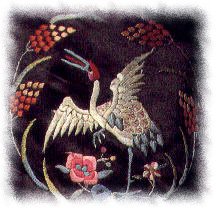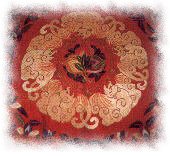Visual Arts -- Embroidery
As one of the ancient handicrafts of China, embroidery has greatly contributed to the progress and enhancement of China's material civilization. China is the first country in the world that discovered the use of silk. Silkworms were domesticated as early as 5000 years ago, and the production of silk thread and fabrics gave rise to the art of embroidery.
Tradition
Historical documents record the use of embroidery in China as early as 2255 B.C. Originally used to signify one's caste position, embroidery later came to have a purely ornamental value and evolved into a favored art form of the common people. As embroidery developed, its artistic features multiplied. Archaeological discoveries reveal that while embroidery remained crudely simple throughout the Chou dynasty, it became increasingly sophisticated during the Warring States Period (475-221 B.C.), and reached an aesthetic peak in the Han dynasty (206 B.C.-221 A.D.).

|
After the Han dynasty, the development of embroidery continued. The hallmark of embroidery in the succeeding centuries was the introduction of religious motifs. Buddhism was introduced into China from India over the following seven hundred years, and to show their sincerity and respect, Chinese Buddhists chose embroidery, which was a symbol of honor and diligence, as their favorite media for portraying Buddhist imagery. Large in size and scope, the colossal works of Buddhist embroidery were in great demand during the Tang dynasty (618-907 A.D.). The pieces were crafted with the strictest attention to detail and employed an inspiring palette of colors. Buddhist embroidery is thus considered to be one of the distinct successes of classical embroidery.
Another Tang dynasty accomplishment was the development of new embroidery stitches. Prior to the Tang dynasty, the chain stitch was the only way commonly used in embroidery. Then, in the Tang, the satin stitch was invented and quickly replaced the chain stitch. The satin stitch has been popular with embroiderers ever since because it frees them to use different stitching styles and to create artful new patterns.
The embroiders of the Sung dynasty (960-1280) attained tremendous success due to three phenomena. First, the satin stitch was permutational and many other new stitches were derived from it. Second, tools and materials used in embroidery were greatly improved during the Sung dynasty. For example, Sung artisans used delicately made steel needles and thread as thin as hair. Third, the art of embroidery completely merged with the art of painting. Embroiderers would actually stitch duplicates of paintings. Because they comprised hundreds of thousands of intricate stitches in a vast spectrum of pleasing colors, the resulting images of Sung embroidery were strikingly vivid and lifelike.
Ming (1368-1644) embroidery had three major distinctive features. First, embroidery was very popular and was used extensively by people of different social classes for a wide variety of purposes. Second, the quality of embroidery for practical uses was greatly improved as embroidery materials were further refined and embroidering techniques further matured. Professional embroiderers and even whole families gained fame for their embroidery skills during the Ming dynasty.

Bring Luck and Wealth |
Flourishing throughout the Ching dynasty (1644-1911), embroidery underwent two noteworthy changes during this period. First, it became more regional in style, with embroidery from Kiangsu, Kwangtung, Szechwan, Hunan, Peking, and Shantung enjoying special acclaim at the time. Embroiders of each province strove to set their styles apart from the embroiders of other provinces through technical and thematic innovation. Second, some embroiderers in the late Ching dynasty began experimenting with Japanese embroidery while others began working within the aesthetic framework provided by western painting.
Modern Day
Today, silk embroidery is practiced in nearly all regions of China. The best commercial products come from four provinces: Jiangsu (notably Suzhou), Hunan, Sichuan and Guangdong, each with its distinctive features.
Embroidered works have become highly complex and exquisite today. In creating the double-face embroidered "Cat", which is characteristic of Suzhou embroidery, the artist splits the hair-thin colored silk thread into filaments which are 1/2, 1/4, 1/12, or even 1/48 of their original thickness-- and uses these to embroider. In the process, the artist conceals thousands of ends and joints and makes them disappear as if by magic. The finished work is a cute and mischievous-looking cat on both sides of the groundwork. Recently, on the basis of two-face embroidery further innovations have been developed.



 Chinese Culture
Chinese Culture